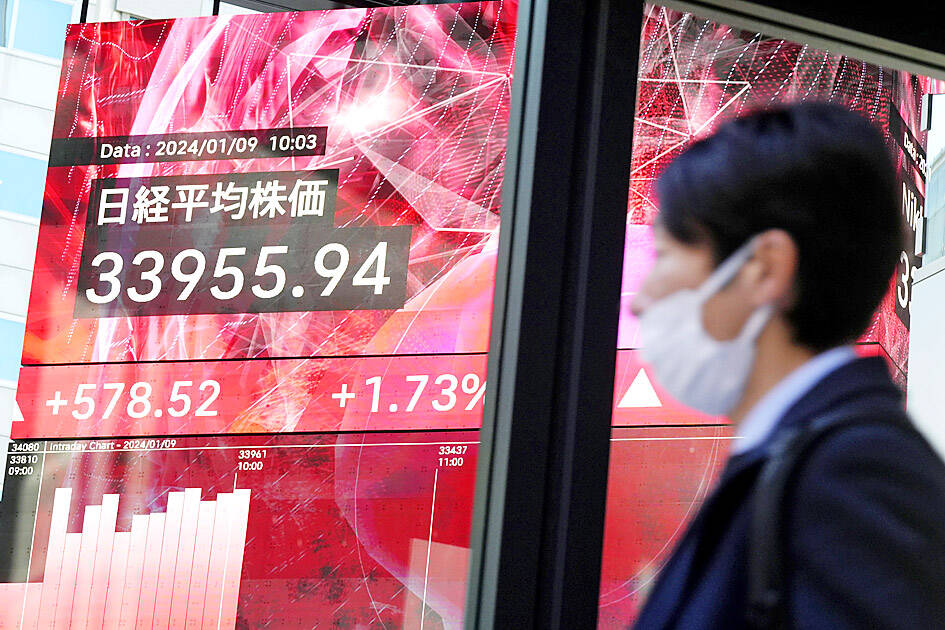Japan’s Nikkei 225 Stock Average yesterday climbed to its highest since the nation’s bubble economy era more than three decades ago, reflecting investor optimism that growth is returning after the country’s long battle with deflation.
The blue-chip gauge rose 1.2 percent to close at 33,763.18 in Tokyo, a level unseen since March 1990, lifted by a rebound in technology shares and a drop in Treasury yields. The benchmark TOPIX, which some funds prefer to follow because it is more comprehensive, gained 0.8 percent.
Both the Nikkei 225 and TOPIX completed an annual advance of more than 25 percent last year, their best performance in a decade. The measures were among the world’s biggest gainers last year as authorities pushed companies to improve shareholder value, while decades-long deflation faded and was replaced by mild price gains.

Photo: AP
A yen rate that remains weak historically despite a recent rebound has supported exporters, and optimism after Warren Buffett parked more of his cash in Japan’s biggest trading companies has also boosted equities in the world’s third-largest economy.
“Japanese stocks have been cheap for a long time,” and signs of corporate governance reforms and Buffett’s investments mean the Nikkei’s return to a three-decade high was not that surprising, Sumitomo Mitsui Trust Bank Ltd strategist Ayako Sera said.
“It’s important to watch if the Nikkei can reach a record high now,” she said. “The 40,000 yen level still seems quite far away.
Elsewhere in Asia, there were also gains in Bangkok, Manila, Mumbai, Shanghai, Singapore, Sydney and Wellington.
The advances came as traders try to ascertain the US Federal Reserve’s plans for interest rates this year, with focus firmly on the release this week of key inflation data.
The outlook was given a boost by a plunge in oil prices — a key driver of inflation — on Monday after Saudi Arabian Oil Co announced a cut of US$2 a barrel as it looks to regain lost market share, a move that fanned concerns that supply was far outstripping demand, particularly with China’s economy still struggling.
Equities in Hong Kong ended 0.21 percent down as traders failed to maintain early strong momentum, while Seoul shed 0.3 percent.
In Taipei, the TAIEX dipped 0.21 percent to close at 17,535.49 points, failing to sustain its earlier gains and falling below the 20-day moving average of 17,646 points, as it did on Monday.
“Before the presidential vote, which remains tense, many investors preferred to take advantage of the initial gains and pocketed their money,” Mega International Investment Services Corp (兆豐國際投顧) analyst Alex Huang (黃國偉) said. “They simply wanted to hold on to as much money as possible for the moment before reinvesting their funds after the election.”
Additional reporting by AFP and CNA

Taiwan Semiconductor Manufacturing Co (TSMC, 台積電) yesterday said that its investment plan in Arizona is going according to schedule, following a local media report claiming that the company is planning to break ground on its third wafer fab in the US in June. In a statement, TSMC said it does not comment on market speculation, but that its investments in Arizona are proceeding well. TSMC is investing more than US$65 billion in Arizona to build three advanced wafer fabs. The first one has started production using the 4-nanometer (nm) process, while the second one would start mass production using the

When an apartment comes up for rent in Germany’s big cities, hundreds of prospective tenants often queue down the street to view it, but the acute shortage of affordable housing is getting scant attention ahead of today’s snap general election. “Housing is one of the main problems for people, but nobody talks about it, nobody takes it seriously,” said Andreas Ibel, president of Build Europe, an association representing housing developers. Migration and the sluggish economy top the list of voters’ concerns, but analysts say housing policy fails to break through as returns on investment take time to register, making the

‘SILVER LINING’: Although the news caused TSMC to fall on the local market, an analyst said that as tariffs are not set to go into effect until April, there is still time for negotiations US President Donald Trump on Tuesday said that he would likely impose tariffs on semiconductor, automobile and pharmaceutical imports of about 25 percent, with an announcement coming as soon as April 2 in a move that would represent a dramatic widening of the US leader’s trade war. “I probably will tell you that on April 2, but it’ll be in the neighborhood of 25 percent,” Trump told reporters at his Mar-a-Lago club when asked about his plan for auto tariffs. Asked about similar levies on pharmaceutical drugs and semiconductors, the president said that “it’ll be 25 percent and higher, and it’ll

CHIP BOOM: Revenue for the semiconductor industry is set to reach US$1 trillion by 2032, opening up opportunities for the chip pacakging and testing company, it said ASE Technology Holding Co (日月光投控), the world’s largest provider of outsourced semiconductor assembly and test (OSAT) services, yesterday launched a new advanced manufacturing facility in Penang, Malaysia, aiming to meet growing demand for emerging technologies such as generative artificial intelligence (AI) applications. The US$300 million facility is a critical step in expanding ASE’s global footprint, offering an alternative for customers from the US, Europe, Japan, South Korea and China to assemble and test chips outside of Taiwan amid efforts to diversify supply chains. The plant, the company’s fifth in Malaysia, is part of a strategic expansion plan that would more than triple